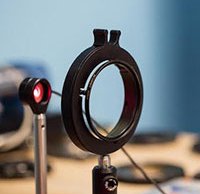Are expensive UV filters better? Do manufacturers lie about transmission? Lensrentals tests 20 UV filters
posted Monday, June 5, 2017 at 11:00 AM EDT

Protective filters…a topic we have discussed on numerous occasions. Typically, UV filters come up on Imaging Resource when a new filter is announced or when Lensrentals founder Roger Cicala writes about them. This time it’s the latter as Cicala is talking again about UV filters and this time he and his team have done extensive testing of a wide array of UV filters, testing their light transmission, light reflectivity and other optical issues.
For a long time, Cicala did not want to test filters. “Life is too short,” he said in response to hundreds of emails asking him to test them. Besides, he said, he would need “at least $1,500 worth of filters to make even a basic comparison.” Next thing you know, Drew, who Roger “sort of” works for had ordered $1,500 worth of filters and Roger’s employee Brandon had built a gadget which used lasers to measure transmission through filters. Everyone loves lasers, including Cicala, so he got around to the filter testing.
As general information for the UV filter testing, you should know that “plain uncoated glass passes through about 96% of light and reflects back 4%. It does this at both surfaces so if you shine a light through a flat piece of uncoated glass, about 92% of the light passes through.” If you coat glass, you can pass through a lot more light. The composition of the coating affects transmission and different filter manufacturers use different coatings. Cicala and others aimed a collimated laser diode (635nm wavelength) through different filters at a light meter many times. Many filter manufacturers make claims about their light transmission capabilities, so Cicala was able to test those claims and see which manufacturers overstated their filter’s capabilities.

You can see the full measured transmission results here, but there was a wide variety of results in the 20 filters tested and the results did not always correspond with the price of the filters. While the best-performing filter in terms of light transmission was also the most expensive, a $225 Leica UVA II filter, a $20 Hoya HMC Multicoated UV(C) filter tested at 99.5% transmission, the same as a filter which costs $124 and better than many filters costing twice as much or more as the Hoya HMC. It is worth noting in the results that there’s no obvious difference in transmission capabilities between a UV filter and a “clear” filter.
So how important is a 1% difference in transmission? Consider that any light not transmitted is reflected and the more light reflected, the greater the risk of ghosting, glare and decreased contrast in your images, which is very important. To help illustrate that, Cicala also created a table showing the percentage of light which is reflected by each filter, starting of course with the Leica filter and its 0.1% reflection result and ending with a $43 dollar Tiffen Digital Ultra Clear filter, which reflected 9.9% of light (very bad result). Cicala is “confident the difference between 0.5% and 1.3% is significant,” and he continues, “I’ll bet my house that 8% reflection causes problems.”

There is more to UV and clear filters than transmission. As Cicala puts it, “just because the light gets through the filter doesn’t mean it gets through without distortion or aberration.” If a filter isn’t flat and has waves across its surface, light could still get through but it may be distorted in ways that affect image quality. To test this aspect of the filters out, the team used pinholes and shot with a 70-200mm f/2.8 lens. Additional information on methodology is available in an addendum in the article, but the primary takeaway is that the filters do in fact handle the transmitted light in different ways, with some showing significant issues. This test is more subjective than the transmission tests, so there are sample images for you to pour over, but there were four filters which Roger and Aaron Closz independently determined have adverse effects on image quality, whereas the others, while different, were unlikely to cause issues with image quality due to how the transmitted light passed through the filters.

What is the conclusion drawn by Cicala from these filter tests? Head on over to the blog post for all the numbers, images and his takeaway. Suffice it to say, there are some filters which may not be worth their high price and there are other filters you should absolutely avoid using. Considering price and performance, Cicala has come up with a list of 10 UV/clear filters which are acceptable by his testing methodology. For those who don’t want to break the bank to protect their lenses, don’t worry, the $20 Hoya HMC Multicoated UV(C) filter makes the final cut.
• Lensrentals UV/clear filter test • Rent cameras and lenses •
(Via SLR Lounge)